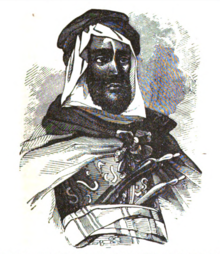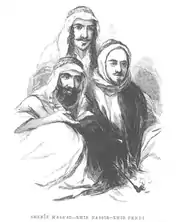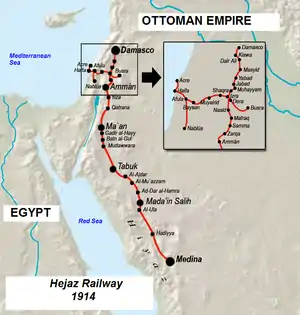Fendi Al-Fayez
Fendi Abbas Salameh Al Fayez (Arabic: فندي عباس سلامه الفايز; 1879-1800) was an Arab leader from the Al-Fayez family who was the chief Sheikh of the Bani Sakher Clan from the 1820s up until his death. He is widely regarded as the most influential figure in the Bani Sakher and one of the most powerful tribal figures in Arabia in the 19th century. Fendi's first documented tribal battle was as early as 1820[1] when he was just twenty years old.
Fendi Abbas Salameh Al-Fayez | |
|---|---|
 Fendi Al-Fayez c. 1873 | |
| Died | April 14, 1879 (aged 78) |
| Resting place | Abila, Jordan |
| Occupation | Arabian Leader |
| Years active | 1820–1879 |
| Relatives | Sattam Al-Fayez (Son)
Mithqal Al Fayez (Grandson) Akef Al-Fayez (Great Grandson) |
By the end of his reign he expanded his tribes' territory to cover large portions of Madaba, Um Al Amad, Al Jeezah, Al Qastal, Jibāl al Lafīfah, parts of Ajloun, Dhiban, and other areas in South Amman and in Ma'an. He would also collect Jizya in the Plains of Esdraelon and Tiberias and would stay there for vacation.[2] Fendi's vast lands, 4,500-strong army,[3] his leading of his army to guard the pilgrims, and his demeanor, are likely the reasons for him being attributed the title of the Old King.[4][5]
Fendi had 14 sons: Satm, Sattam, Tallal, Haza', S'fouq, Muhammad, Barjas, Nayef, Farhan, Jrooh, Hayel, Sahen, Saleh, and Jid'an. He was succeeded by his son Satm Al-Fayez, who immediately was faced with a schism in his family following Fendi's death.
Fendi's descendants would continue to lead the Al-Fayez family and the Bani Sakher.
Appearance
Fendi's appearance has been described by multiple authors who have entertained him from Europe. Fendi is described as an intimidating man with "an iron-beard, strongly marked features, fine and prominent nose, large liquid black eyes, and a rather surly expression of countenance". He carries with him his scimitar and pistol, both engraved with silver.[4] Fendi also had on him a "Damascus blade that he kept with care, also a coat of mail, which probably dated from early Saracenic times " which would could've originated from as early as the 8th century AD.[3]
Bani Sakher under Fendi

It's widely regarded that under Fendi, Bani Sakher experienced the fastest growth in terms of population, land, and wealth. In 1810 the Beni Sakher were able to defend against a joint attack from Sulayman Pasha of Damascus, Sheikh Hamoud Al-Saleh of the Adwan, and the Ruwala. It's unlikely that Fendi was present in this battle, however it marked the beginning of a long history of victories that led to the Beni Sakher expansion of the 19th century Fendi was a large contributor to. In the 1830s, John L. Burckhardt reported that the Beni Sakher's forces amounted to around 500 men.[6] In 1863, Henry B. Tristram saw the Beni Sakher camped in the Ghor region, his description puts them at many times the figure that Burchkardt explained around 35 years prior. Tristram wrote:
“When, in 1863, they encamped in the Ghor [the Jordan Valley], just before their raid on the plain of Esdraelon, their tents, like the Midianites’, covered the ground for miles, far as the eye could reach from the Mount of Beisan, and in a week there was not a green blade to be seen, where before the arrival of these locusts one stood knee-deep in the rank herbage.”
In 1877 this was estimated again to be at 4,500.[3]
Fendi would also focus heavily on trade, he reportedly was arranging the sale of camels for the haj , and was earning £1,500 a year from selling or hiring camels.[7]
Guardian of the Pilgrims

Under Fendi, the Bani Sakher tribe became the guardians of the muslim pilgrims to Mecca. Fendi would muster 700 camel-men to protect the pilgrims from Hauran till 6 days south of Al-Kerak.[4] On Camel this journey would've covered around 260 km (~162 miles), and covers the distance from the Mount Hauran till beyond the borders of modern day Jordan, finally reaching Halat Ammar in modern day Saudi Arabia. Fendi would be responsible for ensuring the pilgrim's safety from the early 1860s till 1869, then again from 1872 till his death. This honor is a result of Fendi's good relationship with the Ottoman State, Reshid Pasha contracted with Fendi to protect and provide for the pilgrims throughout this distance. This has added to the Fendi and his family's wealth alongside their camel trading business.[8] The family would continue to guardian the pilgrims up until the opening of the Hijaz Railway in the late 1910s.
Death
On his way back from Nablus, Fendi fell ill, and died inside the territory of the Adwan tribe. Although the Bani Sakhr and the Adwan were enemies at the time, Arabian customs of respect where uphold by his adversaries and Fendi Al-Fayez was buried in Abila, at the junction of Wady Rameh and Wady el Kefrein. After Fendi died, his eight sons were conflicted on who will rule after him. His eight sons have split the family and tribe, with one, consisting of mostly the older brothers allied with the Adwan, and the other under Satm allied with the Anazeh and the Ottomans. The tribe eventually reunited in under 1881 after Satm's death in a skirmish with the Adwan.[9] Sheikh Sattam, who Fendi has already given him much of his responsibilities prior to his death became the Sheikh of the Bani Sakhr.
Tomb
His tomb was modeled after Roman Sarcophagi which how Arab Bedouins honor famous heroes, and it's dimensions are 3 m (10 ft) tall by 3m long by 2m (6'6 ft) wide. The tribe mark of the Fayez family is shown on the west end of the tomb. The tomb was made so that Fendi was lying on his right side, and facing Mecca. The tomb area is enclosed by a quadrangular with rounded corners, It measured 5.2 m (17 ft) by 4.6m (15 feet), and the wall is around half a meter (1'6 ft) tall. On the sides of the tomb, a crutch headed sticks that have an exact resemblance of one of the scepters of Osiris, a sword, coffee cups, and other symbols can be seen on the tomb walls.[10]

References
- Peake, Frederick (1958). A History of Jordan and It's Tribes. Coral Gables, Florida: University of Miami Press. p. 156.
- Conder, Claude (1880). Tent Work in Palestine. Richard Bentley & Son, New Burlington Street, London.: Published for the Committee of the Palestine Exploration Fund. p. 223.
- Kitchener, H.H (7 September 1877). "Journal of the Survey" (PDF). Palestine Exploration Quarterly. 10: 11.
- Tristram, Henry Baker (1873). The Land of Moab. London, Murray, Albemarle Street: Cambridge University Press. pp. 226–228. ISBN 9781108042062.
- Fish, Henry C (1876). Bible Lands Illustrated. Columbia University: American Publishing Company. p. 305.
- Burckhardt, John L. (1830). Notes on the Bedouins and the Wahabys. LONDON : HENRY COLBURN AND RICHARD BENTLEY, NEW BURLINGTON STREET.: THE ASSOCIATION FOR PROMOTING THE DISCOVERY OF THE INTERIOR PARTS OF AFRICA. p. 14.
- Kitchener, H.H. "Journal of the Survey". Palestine Exploration Quarterly. 10: 63.
- Alon, Yoav (2016). The Shaykh of Shaykhs. Stanford, California: Stanford University Press. p. 14. ISBN 9780804799348.
- Conder, Claude (1883). Heth and Moab. Richard Bentley & Son, New Burlington Street, London.: Bentley.
- CONDER, D.C.L., R.E., MAJOR C. R. (1889). The Survey of Eastern Palestine. Adam Street, Adelphi, London: THE COMMITTEE OF THE PALESTINE EXPLORATION FUND. pp. 113–115.CS1 maint: multiple names: authors list (link)